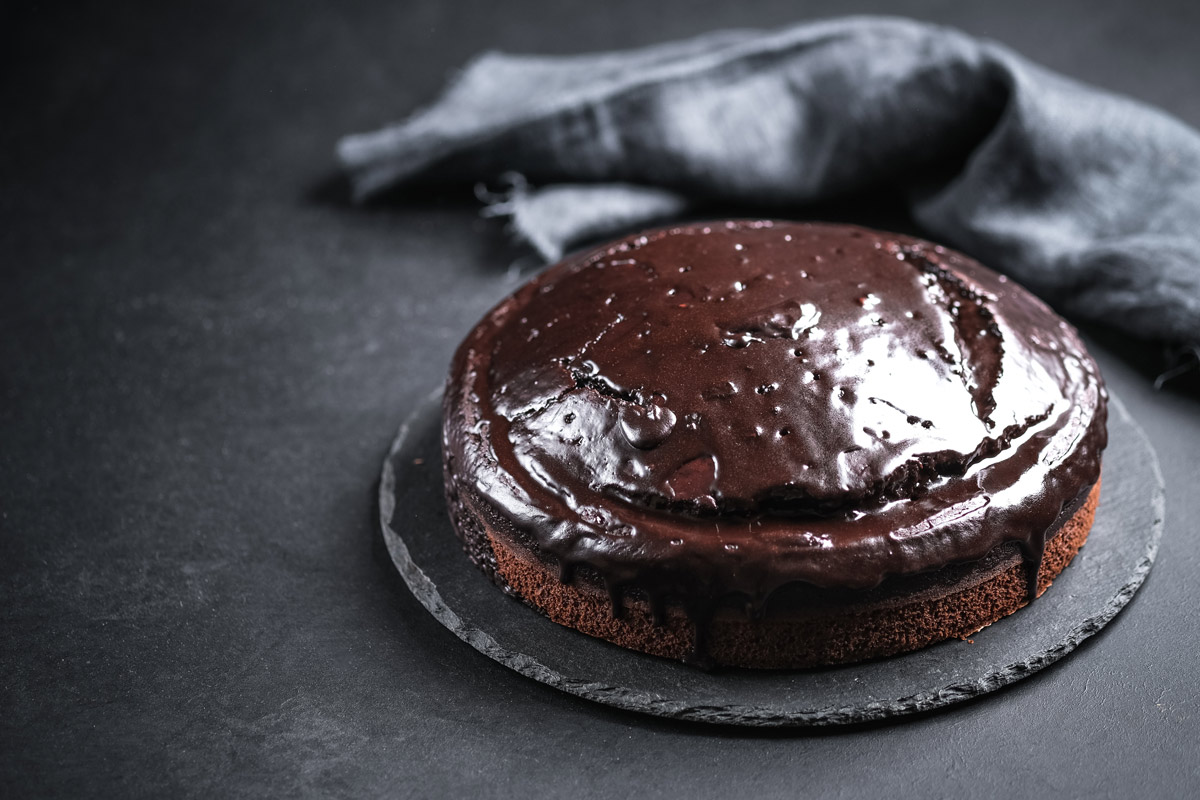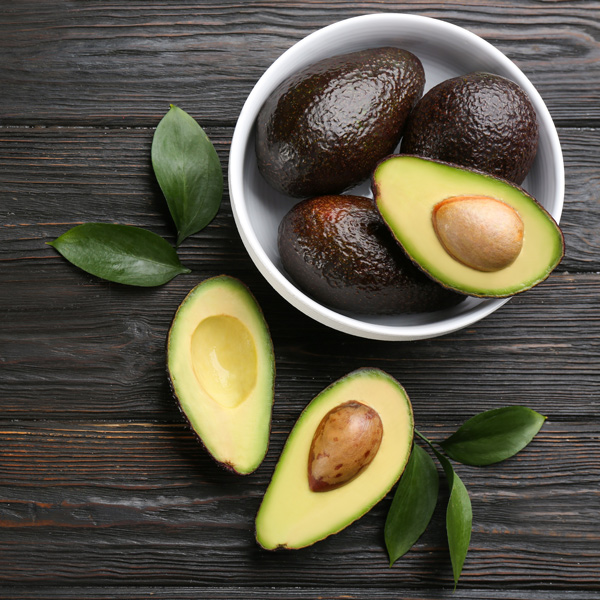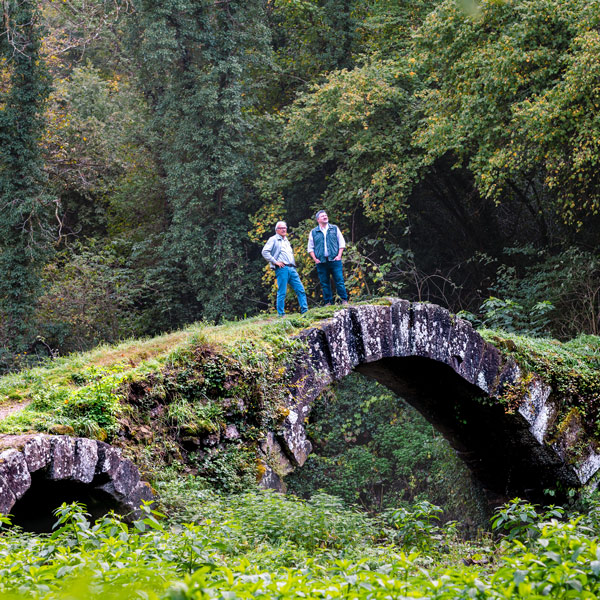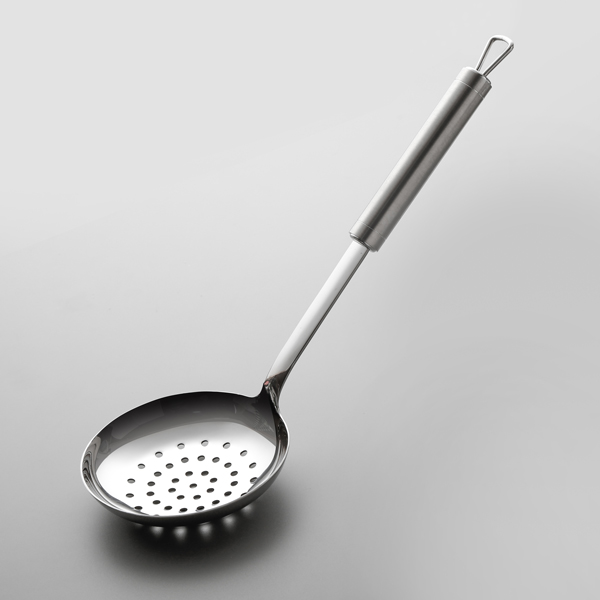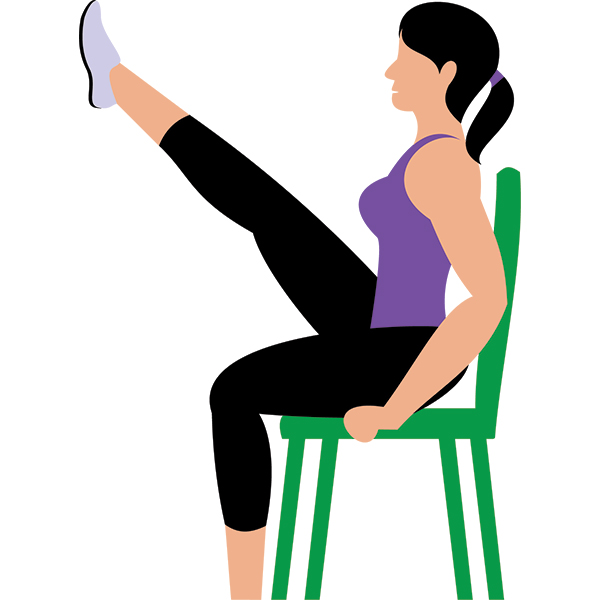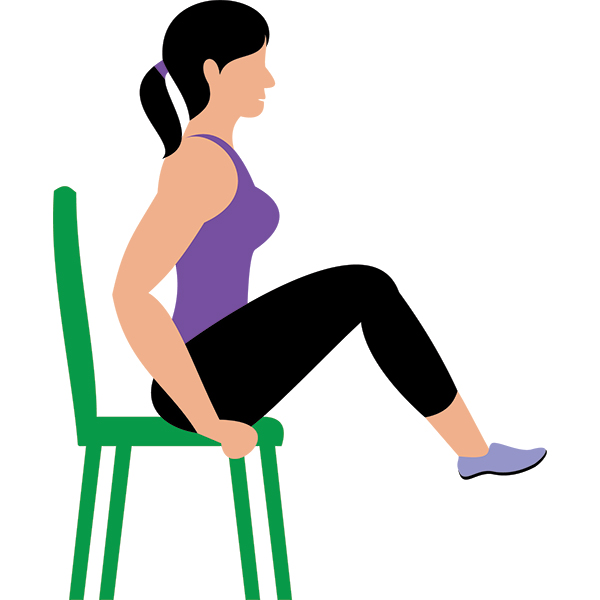Composed Salad with Apple Balsamic Vinaigrette Recipe, Spotlight on Salad Greens, A Monthly 5-day Modified Fast to Boost Longevity and A Surprising Advantage of Exercise
Composed salad—only the name of this dish sounds tricky. It’s actually a simple technique to arrange ingredients in a beautiful display and let everyone pick and choose what to put on their own plate. I’ve provided suggestions, but you get to pick your culinary adventure!
Club members know that I believe in nourishing the body with healthful foods (that’s why sourcing fresh-pressed olive oil brimming with polyphenols is so important to me!). And in turn, the body can enrich us in remarkable ways. Two studies provide astounding food for thought to prove that point. The first is a new approach to intermittent fasting, and the second shows how bookmarking learning something new with bouts of physical exercise can help you retain the new information. Enjoy these fascinating reads.
Composed Salad with Apple Balsamic Vinaigrette
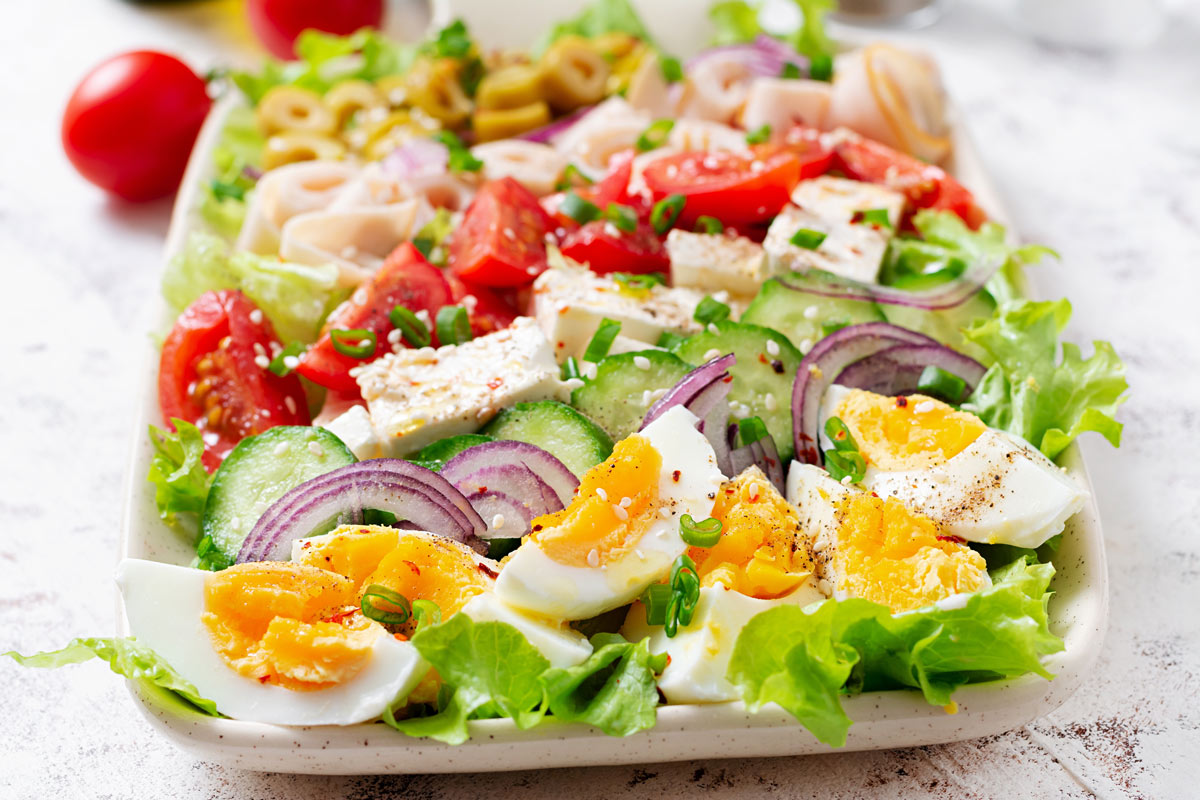 Composed Salad with Apple Balsamic Vinaigrette
Composed Salad with Apple Balsamic VinaigretteSounds complicated and even more exotic in its original French—“salade composée”—but a composed salad is nothing more than an artful way to arrange your ingredients rather than tossing them together. Salade Niçoise and Cobb salad are two that are typically presented this way, but a composed salad can be made of any ingredients you choose—and it’s a great way to showcase fresh seasonal vegetables and even fruits. The following ingredients and directions are merely guidelines—let your imagination be your guide and remember that unusual combos can be delicious. Whatever you choose should have a flavorful dressing, so I’m including the recipe for one of my favorite vinaigrettes. It uses apple balsamic vinegar, a great change from classic balsamic of Modena.
Ingredients
For the vinaigrette:
- 1⁄4 cup Apple Balsamic Vinegar
- 1⁄4 teaspoon dried basil leaves, crushed
- 1 small shallot, minced
- 1 garlic clove, minced
- Pinch red pepper flakes
- 1⁄2 cup extra virgin olive oil
- Coarse salt and freshly ground black pepper to taste
For the platter, choose any combination:
- Protein: pick 1 or 2, such as sliced chicken, hard-boiled egg halves, or strips of prosciutto
- Cheese: pick 1 or 2 such as cubes of fresh mozzarella or aged Parmigiano-Reggiano, or thin rounds of goat cheese
- Greens: pick 1 lettuce or another leafy green, like arugula or baby spinach
- Vegetables: pick 3 or 4, raw, steamed, or grilled, such as asparagus, cherry tomatoes, and string beans
- Fruit and nuts: pick 1 or more, such as grapes, apple or pear slices, raisins or another dried fruit, avocado, and almonds or walnuts
- Legumes: pick 1, such as cooked beans or chickpeas
Directions
Step 1
Make the vinaigrette: In a medium mixing bowl, whisk together the vinegar, basil, shallot, garlic, and red pepper flakes. Gradually whisk in the olive oil until the dressing is emulsified. Season to taste with salt and pepper.
Step 2
Compose your salad: Rinse and pat dry all raw ingredients. Cut all ingredients into bite-size pieces or thin slices. Lettuces and other greens can be sliced into ribbons. Choose a large platter and place one ingredient at a time, going from left to right.
Step 3
Place the vinaigrette on the side so each person can add as much or as little as they want.
Yields 4 servings

Healthy Ingredient Spotlight
Salad Greens
I’m a fan of varying the greens in my salads rather than sticking to one type every time. This choice goes beyond taste—each green has a different nutrient profile, so mixing it up means you get a wider range of vitamins, minerals, and other phytochemicals. Here are some choices to put in your own personal rotation.
Iceberg is one of the few lettuces that comes in a very compact head; another is romaine. The leaves of the more delicate butterhead and Boston lettuces are more loosely held together. Red or green loose-leaf lettuce and escarole aren’t compact at all.
Many greens are sold as leaves, bundled or loose, including watercress, Swiss chard, arugula, baby spinach, and dandelion greens. Some leaves, like kale, have rigid spines or stems that you might want to remove if eating raw but that soften when cooked.
All greens are a good source of fiber and water. Romaine and spinach have the highest amounts of vitamin A and folate (a B vitamin), spinach and Swiss chard are highest in vitamin K and potassium, and kale and spinach take top honors for calcium.

Quick Kitchen Nugget
Storing Salad Greens

It’s frustrating to buy a box or package of greens—or even a loose head—only to find that some of the leaves have turned when you go to make a salad. These quick tips can help keep them fresh.
If possible, store greens by themselves (and definitely away from any fruit) in one of the crisper drawers of your fridge with the humidity set at high. Newer, more high-tech refrigerators offer very precise climate control, sometimes through an app on your phone.
If your greens are bagged, you can try the puffing technique: blow into the bag to puff it up (like a balloon) and then seal in the air by closing the bag with a rubber band. Another option, especially if your greens are in a plastic clamshell or tight bag, is to spread them out in single layers between sheets of paper towels (discard any leaves that have wilted), roll up the paper towels, and store the roll in a reusable container. Rinse before eating, not before storing.

For Your Best Health
A Monthly 5-day Modified Fast to Boost Longevity
We’ve shared reports of studies showing that you may be able to reduce inflammation and better ward off diseases with intermittent fasting—eating fewer than 500 calories on two days of every week or limiting eating to an 8- or 10-hour daily window. Recently, a University of Southern California Leonard Davis School of Gerontology-led study, published in the journal Nature Communications, found that one five-day monthly cycle of a diet that mimics fasting, known as a fasting-mimicking diet (FMD), can reduce signs of immune system aging, as well as insulin resistance and liver fat, resulting in a lower “biological” age—a measure of how well your cells and tissues are functioning regardless of your chronological age.
The FMD, developed by Valter Longo, PhD, the study’s senior author and professor at the USC Leonard Davis School, is high in unsaturated fats and low in overall calories, protein, and carbohydrates. It’s designed to mimic the effects of a water-only fast while still providing necessary nutrients and making it much easier for people to complete.
“This is the first study to show that a food-based intervention that does not require chronic dietary or other lifestyle changes can make people biologically younger, based both on changes in risk factors for aging and disease and on a validated method developed by the Levine group to assess biological age,” Dr. Longo said. (The Levine group, led by Morgan Levine, PhD, designs tools just to measure biological age.)
Previous research led by Longo indicated that brief, periodic FMD cycles are associated with a range of beneficial effects, such as promoting stem cell regeneration, easing chemotherapy side effects, and reducing the signs of dementia in mice. Dr. Longo’s lab also had previously shown that one or two cycles of the FMD for five days a month increased the health span and lifespan of mice on either a normal or a Western diet, but the effects of the FMD on aging and biological age, liver fat, and immune system aging in humans were unknown until now. In addition, the FMD cycles can lower the risk factors for cancer, diabetes, heart disease, and other age-related diseases in people.
The study analyzed the diet’s effects in two clinical trial populations, each with men and women between the ages of 18 and 70. Patients who were randomized to the fasting-mimicking diet underwent 3-4 monthly cycles, adhering to the FMD for 5 days, then ate a normal diet for 25 days. The FMD is comprised of plant-based soups, energy bars, energy drinks, chip snacks, and tea plus a supplement providing high levels of minerals, vitamins, and essential fatty acids.
An analysis of blood samples from trial participants showed that those in the FMD group had lower diabetes risk factors, including less insulin resistance and lower HbA1c results. Magnetic resonance imaging also revealed a decrease in abdominal fat as well as fat within the liver, improvements associated with a reduced risk of metabolic syndrome. In addition, the FMD cycles appeared to increase the lymphoid-to-myeloid ratio, an indicator of a more youthful immune system. Further statistical analysis of the results showed that FMD participants had reduced their biological age by 2.5 years on average.
“This study shows for the first time evidence for biological age reduction from two different clinical trials, accompanied by evidence of rejuvenation of metabolic and immune function,” Dr. Longo said. It lends more support to the FMD’s potential as a short-term periodic, achievable dietary intervention that can help people lessen their disease risk and improve their health without extensive lifestyle changes, he added.
“Although many doctors are already recommending the FMD in the United States and Europe, these findings should encourage many more healthcare professionals to recommend FMD cycles to patients with higher-than-desired levels of disease risk factors as well as to the general population that may be interested in increased function and younger age,” said Dr. Longo.

Fitness Flash
A Surprising Advantage of Exercise
Looking to improve your fine motor skills? You can benefit from physical exercise both before and after practicing these skills, according to new research from the department of nutrition, exercise, and sports at the University of Copenhagen. This finding also can, among other things, make the way we rehabilitate more effective.
Before a violinist wants to learn a new piece or a surgeon stands at the training table to learn a new surgical technique, they might consider heading out for a bike ride or run. Once they’ve practiced the new skill, there’s good reason to put on their workout attire again. Indeed, being physically active and elevating one’s heart rate has the wonderful side effect of improving our ability to learn by increasing the brain’s ability to remember, stated the researchers. They showed that this effect also applies to the formation of motor memory, enabling us to recall and perform tasks such as riding a bike, driving a car, and lacing up our shoes, almost automatically.

“Our results demonstrate that there is a clear effect across the board. If you exercise before learning a skill, you will improve and remember what you have learned better. The same applies if you exercise after learning,” said Lasse Jespersen, PhD, first author of the study. Specifically, the researchers found around 10% improvement in people’s ability to remember a newly learned motor skill when exercise is included either before or after the new skill. “But our research shows that the greatest effect is achieved if you exercise both before and after,” Dr. Jespersen added.
“This is probably because physical activity increases the brain’s ability to change, which is a prerequisite for remembering,” explained co-author Jesper Lundbye-Jensen, PhD, who heads the department’s movement and neuroscience section. Specific parts of the brain are activated when a person engages in motor practice that requires the acquisition of fine motor skills. If the task is an activity that one knows well, like riding a bicycle, the centers are less active, but that all changes when learning something new. The brain undergoes actual changes, something that is essential for our ability to learn and remember new skills, a phenomenon known as brain plasticity. These changes occur not only while the new skill is acquired through practice but also in the hours after, when the memory is consolidated. This is why it is meaningful to be physically active even after we’ve engaged in something new.
The effect applies to everyone, including children, adolescents, and older adults, and in particular anyone who regularly needs to learn new skills. Moreover, the effects may hold significance for individuals undergoing rehabilitation, aiming to recover mobility and lost motor skills.
“Typically, rehabilitation is divided between two or three different disciplines. In practice, this may mean that Mr. Smith will have physical training with a physiotherapist on one day, work with an ergonomist the next, and train cognitive abilities with a psychologist on the third. Our research suggests that it could be wise to plan rehabilitation so that these areas are considered together, as doing so could have a synergistic effect,” explained Dr. Lundbye-Jensen. “Coming back often entails hard work, and even slight improvements in efficiency can mean a lot to people in that situation.”
Sixty-seven test subjects were involved in the research project. To ensure comparable data, all subjects were young men between the ages of 18 and 35 who were not physically or mentally impaired in ways that could limit their learning ability and physical performance.
The researchers examined the subjects’ behavior and performance while reviewing one of four possible scenarios. First, the subjects either rested or exercised moderately on a bicycle. After that, they were subjected to a fine motor task in the form of a simple computer game that, with a small device on their fingertips, challenged and practiced their motor dexterity.
Next, they either exercised intensely on a fitness bike or rested. That meant there was one group that rested both before and after, one that trained both times, and two that trained once, either before or after. Their skill level and memory were tested again after seven days to assess whether what they had learned stuck.
As a somewhat unusual criterion, professional musicians and gamers were excluded as possible participants. “People with extensive experience in practicing motor skills typically start at a different level. While the motor task used in the research study was unknown to all, involving experts would have changed the dynamic from the get-go. But that doesn’t mean they wouldn’t benefit from the effects we’ve shown. To the contrary, in a future study, it could be exciting to investigate how exercise affects people with elite-level fine motor skills,” said Dr. Jespersen.
Get More Recipes In Your Inbox!
